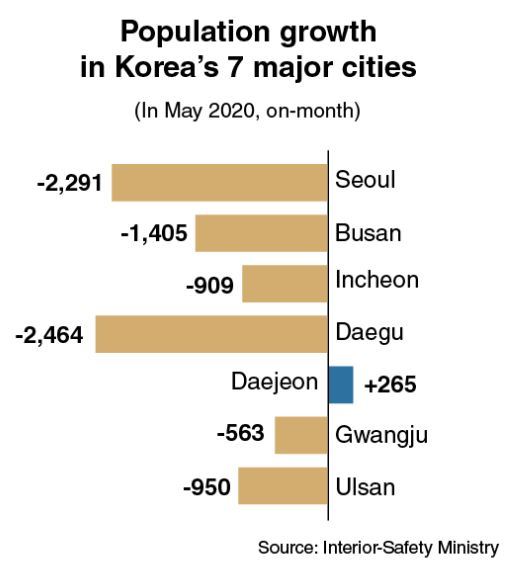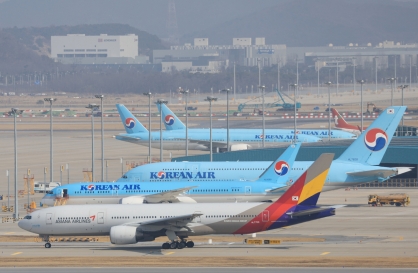 |
College students participate in volunteer activities for a rural community in 1969, when South Korea’s population was rapidly growing. The demographic figure stopped its increase 50 years later in December 2019. (National Archives of Korea) |
SEJONG -- South Korea saw the tally for registered residents post 51.841 million as of May, down 1,153 from the previous month, according to the Ministry of Interior and Safety.
This marked a decline in population for the sixth consecutive month since last December. Compared to November 2019, when the number of residents peaked at 51.851 million, the nation’s population has dropped 10,056 over the past half a year.
The monthly demographic data reflects not only the number of births and deaths but also changes in Korean citizenships as well as Koreans residing overseas and foreigners residing here.
Starting with a decline by 1,566 in December, the population growth recorded minus 2,352 in January, minus 2,882 in February, minus 1,432 in March, minus 671 in April and minus 1,153 in May -- which is an unprecedented case.
The figures are largely unaffected by COVID-19, given that the number of deaths from the epidemic stood at 271 on a collective basis as of June 1, after the first death was reported on Feb. 20.
Korea, previously, had seen negative population growth only twice -- in March 2008 and April 2009. And for a decade between May 2009 and November 2019, the population continually increased on-month.
In May, the number of births was outstripped by deaths: 22,794 vs. 24,654. While the gap between the two was 1,860, citizenship changes (Koreans renouncing their citizenship and foreigners acquiring Korean citizenship) or the long-term resident status of Koreans overseas and foreigners here are estimated to have offset the population decline somewhat, for a total decline of 1,153.
 |
(Graphic by Kim Sun-young/The Korea Herald) |
Interior Ministry data showed that 10 of the 17 major areas (eight cities and nine provinces) recorded lower population figures last month.
Daegu topped the list as the number of its residents dipped by 2,464, followed by North Gyeongsang Province with minus 2,294 (ranked second) and Seoul with minus 2,291 (third).
In March 2011, Seoul had 10.29 million registered residents, but the capital’s population has seen a steady decline since then. It recorded 10.13 million in May 2014, 9.91 million in May 2017, 9.82 million in May 2018 and 9.76 million in May 2019.
In May 2016, the number fell below 10 million (9.99 million) for the first time in 28 years, while the Seoul population had hovered over 10 million since 1988.
A significant number of former Seoulite are estimated to have moved to Gyeonggi Province and Incheon (both of which have many commuters to the capital), or to Sejong (the nation’s new administrative city) over the past decade.
South Gyeongsang Province and North Jeolla Province ranked fourth with minus 2,033 and fifth with minus 1,522, respectively. Among the others, minus 1,405 in population was reported in Busan, minus 950 in Ulsan, minus 909 in Incheon and minus 563 in Gwangju.
In contrast, Gyeonggi Province marked a month-on-month increase by 12,787 to reach an all-time high of 13.324 million. The number of residents in Sejong climbed by 157 to 345,373, which is a marked surge of 89.7 percent growth compared to five years earlier in May 2015, when it stood at 182,028.
The male population in South Korea declined for the 10th consecutive month, falling a cumulative 12,608 during the August 2019-May 2020 period.
The female population rose again in March (plus 316), April (plus 563) and May (plus 326) after posting negative figures for the two consecutive months -- minus 399 in January and minus 510 in February.
“Korea’s fertility rate is the lowest in the world, at 0.9 in the first quarter of 2020 and 0.85 in the fourth quarter of 2019,” said a government official. “we have already entered the era of steady loss in population and are facing a demographic cliff.”
By Kim Yon-se (
kys@heraldcorp.com)





![[From the Scene] Monks, Buddhists hail return of remains of Buddhas](http://res.heraldm.com/phpwas/restmb_idxmake.php?idx=644&simg=/content/image/2024/04/19/20240419050617_0.jpg)



